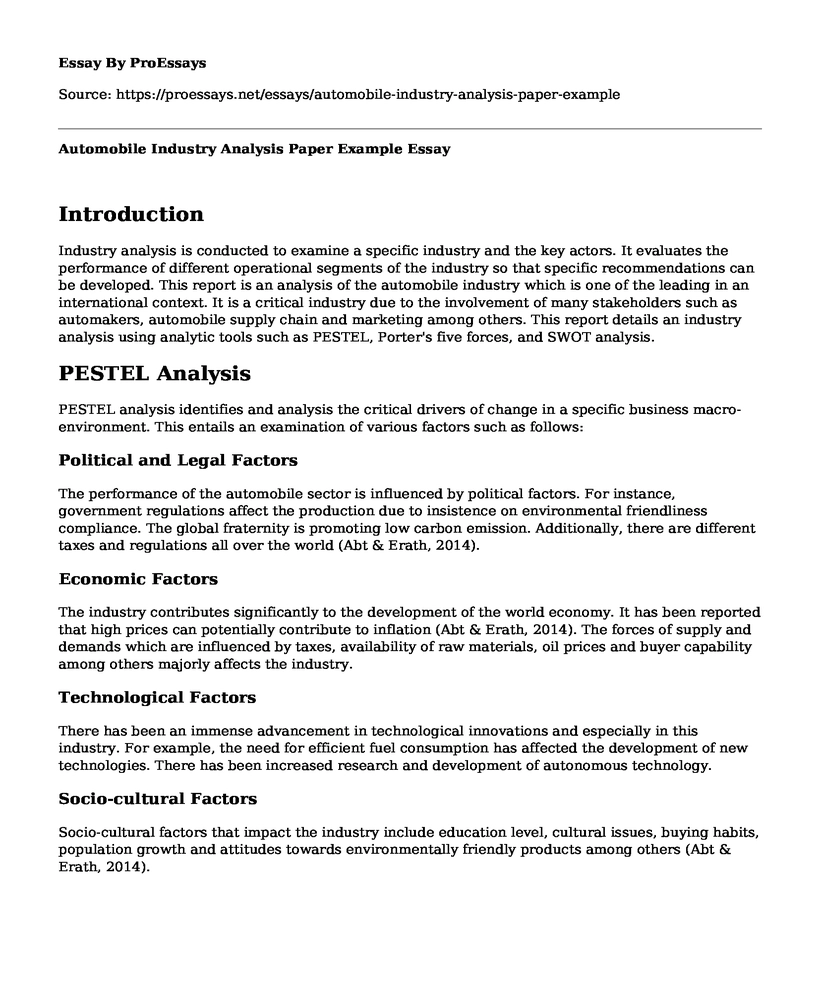Introduction
Industry analysis is conducted to examine a specific industry and the key actors. It evaluates the performance of different operational segments of the industry so that specific recommendations can be developed. This report is an analysis of the automobile industry which is one of the leading in an international context. It is a critical industry due to the involvement of many stakeholders such as automakers, automobile supply chain and marketing among others. This report details an industry analysis using analytic tools such as PESTEL, Porter's five forces, and SWOT analysis.
PESTEL Analysis
PESTEL analysis identifies and analysis the critical drivers of change in a specific business macro-environment. This entails an examination of various factors such as follows:
Political and Legal Factors
The performance of the automobile sector is influenced by political factors. For instance, government regulations affect the production due to insistence on environmental friendliness compliance. The global fraternity is promoting low carbon emission. Additionally, there are different taxes and regulations all over the world (Abt & Erath, 2014).
Economic Factors
The industry contributes significantly to the development of the world economy. It has been reported that high prices can potentially contribute to inflation (Abt & Erath, 2014). The forces of supply and demands which are influenced by taxes, availability of raw materials, oil prices and buyer capability among others majorly affects the industry.
Technological Factors
There has been an immense advancement in technological innovations and especially in this industry. For example, the need for efficient fuel consumption has affected the development of new technologies. There has been increased research and development of autonomous technology.
Socio-cultural Factors
Socio-cultural factors that impact the industry include education level, cultural issues, buying habits, population growth and attitudes towards environmentally friendly products among others (Abt & Erath, 2014).
Environmental Factors
Fuel usage efficiency and air pollution are environmental factors impacting the industry. These affected the development of new technologies.
Porter's Five Forces Analysis
It is a tool that examines competition in a sector. It entails microenvironment forces affecting a business or industry.
Suppliers' Bargaining Power
In the automobile industry, suppliers' bargaining power is considered low due to the presence of many suppliers (Mushtaq & Sarwar, 2011). Technology has developed which means producers can reject materials which do not meet the standards.
Customers' Bargaining Power
In this industry, customers have moderate bargaining power. To make decisions, consumers need the necessary information. In addition, there is a need for information on other factors that affect decisions such as brand, image, quality and price among others.
Competition
The key players in this industry try to compete with each other by satisfying customers' demands. These demands include lower prices and high quality. Some of the major competitors include Mercedes, BMW, Honda, and Volkswagen among others (Mushtaq & Sarwar, 2011).
Threats of Substitutes
There are possibilities for substitutes especially due to product differentiation, and therefore customers have a choice.
New Entrants
The barriers to entry are high and especially due to high initial capital investment.
SWOT Analysis
Strengths: The industry is dynamic due to changing needs of the consumers, and there is high innovation. There is the availability of affordable labor and especially from developing nations such as China (Zhikang, 2017).
Weaknesses: There are high competition, increased taxation, and strict regulations. In the recent past, there have been increased environmental concerns (Shinde & Dubey, 2011).
Opportunities: There is an increased gap for innovation due to technological advancement such as autonomous technology (Shinde & Dubey, 2011). There is also dynamism on customer preference and the emergence of new markets.
Threats: There is high competition and over dependency on the cost of fuel. The industry is also characterized by massive costs of production, and inflation among others (Zhikang, 2017).
Conclusion
Over the years, the automobile has shown constant growth. The growth has been enhanced by the availability of cheap labor from developing nations and technological advancement. Despite this, it faces some challenges such as increased regulations and environmental concerns. The industry analysis conducted indicates the possibility of the continuous growth.
References
Abt, T., & Erath, F. (2014). Power of E-Motion. Retrieved from https://pdfs.semanticscholar.org/d7f0/f78f769cd61f4b40f40db8e5fc902e8354ed.pdf
Mushtaq, N., & Sarwar, J. (2011). A Look into the Future of the Global Automobile Industry with an emphasis on Emerging Fuel Technologies - Rivalry Strategy Impact -. Retrieved from http://studenttheses.cbs.dk/bitstream/handle/10417/3055/najm-us-saqib_mushtaq_og_jalal_sarwar.pdf?sequence=1
Shinde, G., & Dubey, M. (2011). AUTOMOBILE INDUSTRY AND PERFORMANCE OF KEY PLAYERS. Asian Journal of Technology & Management Research, 01(02).
Zhikang, L. (2017). Research on Development Strategy of Automobile Reverse Logistics Based on SWOT Analysis. Procedia Engineering, 174, 324-330. doi: 10.1016/j.proeng.2017.01.147
Cite this page
Automobile Industry Analysis Paper Example. (2022, Aug 15). Retrieved from https://proessays.net/essays/automobile-industry-analysis-paper-example
If you are the original author of this essay and no longer wish to have it published on the ProEssays website, please click below to request its removal:
- Research Proposal on Prevalence of Hypoglycaemia Among Patients with Type 2 Diabetes
- The Strategy and Structure of Advent International Case Study
- Research Paper on Labor Relations: Germany Strikes
- Impact of Price Floor to Unemployment Essay
- Essay Example on Business: A Catalyst for Employment and Opportunity
- Italy's Economic Crisis: Action Needed to Strengthen Growth Prospects - Research Paper
- Essay Sample on Exploring the Benefits of Nvivo 11.0 in Content Analysis







